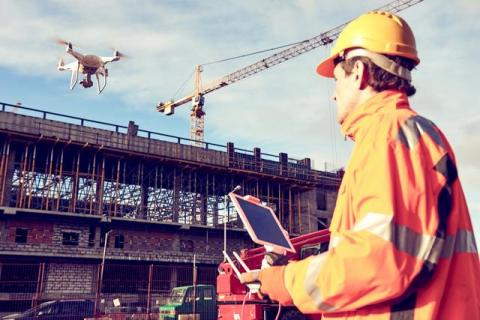Drones and Construction Safety
April 30, 2019Unmanned systems are on the rise in every industry, but did you know that they’ve already been quietly taking over for years in the construction industry? The use of drones not only cuts costs and increases efficiency, it makes construction sites much safer.
The construction industry regularly deals with heavy machinery, heights, and other potentially dangerous situations which unmanned vehicles enable human workers to cut back on. Drones can work without fatigue, allow operators to manage heavy machinery from a distance, and can inspect dangerous situations before people even set foot into the area, significantly reducing the number of on-site injuries.
UAV’s, or unmanned aerial vehicles, are primarily used in the construction industry as highly accurate survey tools. Especially with large construction projects, UAV’s can cover more ground using everything from regular cameras, to infrared, to radar to mapping a site. They can also help track equipment, materials, and people. According to the National Institute of Occupational Safety and Health (NIOSH), “the emerging uses of UAVs in the construction industry range from aiding with construction project planning by aerial mapping of a construction site to extending the actual building of structures.”
When we think of drones, it is UAVs that first come to mind, but in construction, unmanned ground vehicles, UGVs, are really doing the heavy lifting – literally. Iconic construction vehicle producer, Caterpillar or CAT, is already producing and selling haulers and fully automated trucks. According to CAT’s website, “Operator-assist technologies that control specific machine functions to boost productivity and cut costs. Remote control systems that move operators out of cabs and away from hazards. And in some cases, fully autonomous trucks. Massive haulers. Two stories tall. Carrying 250-ton payloads. With no operators in sight. It’s transformational stuff. And it’s happening right now.”
Another big name large equipment provider, Komatsu has been providing UGV’s to construction operations for over a decade. Mining is an especially big industry for these autonomous vehicles. According to Komatsu’s site, “Today there are nearly 150 trucks operating autonomously in 9 mine sites, moving multiple commodities in 3 continents around the world.” Not only are these trucks widely in operation, but Komatsu claims that their AHS technology causes “zero harm,” writing: “Reduce risk with 100 percent compliance to FrontRunner assignments, moving workers from inside the pit to safer working environments. Since its deployment more than a decade ago, there have been zero system-related injuries involving the FrontRunner AHS.”
The bottom line is that unmanned systems save time, cut costs, reduce workflow, and improve safety - and they are already here. As drones become more and more integrated into the construction industry, there will be a greater need for highly skilled labor to oversee and train machines.
Capitol Technology University offers bachelor’s degrees in construction management and critical infrastructure and unmanned and autonomous systems – with an available unmanned and autonomous systems minor. At the masters level we offer masters in critical infrastructure and masters in unmanned and autonomous systems policy and risk management.
Our doctoral program offerings include PhD’s in construction science, critical infrastructure, manufacturing, occupational health and safety, and unmanned systems applications. You can check them out here.



